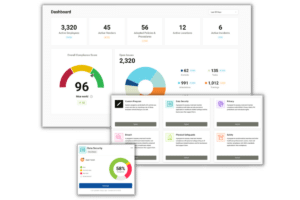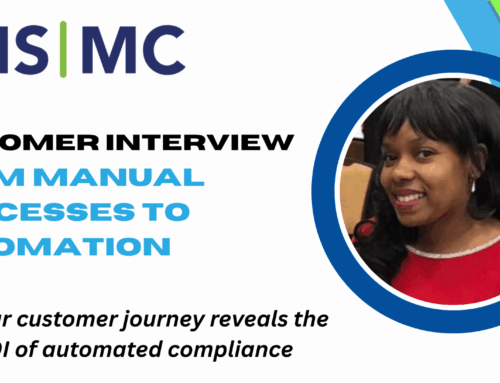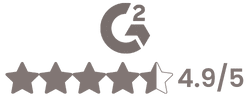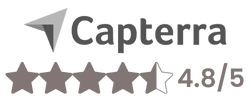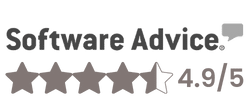
Healthcare organizations today are under immense pressure to stay compliant while also handling their daily tasks, given how complicated regulations have become. A robust compliance monitoring system is no longer optional—it’s essential for protecting patient data, avoiding costly penalties, and building trust with stakeholders.
This comprehensive guide explores how modern compliance monitoring solutions streamline regulatory adherence, reduce administrative burden, and create a culture of accountability throughout your organization.
What is a Compliance Monitoring System?
A compliance monitoring system is a comprehensive platform that automates the tracking, management, and reporting of regulatory requirements. Rather than relying on manual processes and spreadsheets, these systems provide real-time visibility into your compliance posture, identify gaps before they become violations, and generate the documentation needed for audits.
For healthcare organizations, this means continuously monitoring adherence to HIPAA, OSHA, state regulations, and other applicable standards through integrated workflows and automated controls.
Why Healthcare Organizations Need Advanced Compliance Monitoring Solutions
The healthcare compliance landscape has evolved dramatically. With increasing regulatory complexity and heightened enforcement activities, organizations can no longer afford reactive compliance approaches.
The Cost of Non-Compliance
Healthcare data breaches and compliance violations carry severe consequences. Beyond financial penalties that can reach millions of dollars, organizations face reputational damage, loss of patient trust, and potential exclusion from federal healthcare programs. Manual compliance processes leave organizations vulnerable to human error, documentation gaps, and oversight failures.
The Shift to Continuous Monitoring
Traditional annual audits and periodic reviews are insufficient. Regulatory bodies increasingly expect continuous compliance monitoring—ongoing oversight that identifies and addresses issues in real-time rather than discovering problems months later during audits.
Modern compliance monitoring solutions enable this shift by automating routine tasks, providing instant visibility into compliance status, and facilitating proactive risk management.
Key Features of an Effective Compliance Monitoring System
When evaluating compliance monitoring solutions, healthcare organizations should look for platforms that offer comprehensive functionality across all aspects of regulatory management.
Centralized Compliance Dashboard
A unified dashboard provides the command center for your compliance program. The Guard by Compliancy Group exemplifies this approach with its comprehensive compliance dashboard that displays all pending tasks, training completion status, assessment progress, vendor management activities, and incident tracking in one centralized location.
This real-time visibility eliminates the guesswork from compliance management. Rather than checking multiple systems and spreadsheets, compliance officers can instantly assess their organization’s compliance posture and identify areas requiring attention.
Policy and Document Management
Creating and maintaining compliant policies requires significant expertise and time. Leading compliance monitoring systems provide templated, customizable policy documents that meet regulatory requirements while allowing organizations to tailor content to their specific needs.
The Guard offers a comprehensive library of healthcare-compliant policies and procedures, eliminating the need to create documentation from scratch. These templates are regularly updated to reflect regulatory changes, ensuring your policies remain current without constant manual revision.
Risk Assessment Automation
Comprehensive risk assessments are fundamental to HIPAA compliance and other regulatory frameworks. However, traditional assessment processes are time-consuming and complex.
Modern compliance monitoring systems streamline risk assessments through guided workflows. The Guard simplifies this process by presenting straightforward questions that assess your compliance risk. Based on your responses, the system automatically identifies gaps and generates corrective action plans, transforming a weeks-long process into a manageable task.
Compliance Training Management
Staff education is critical for maintaining compliance, yet coordinating training across diverse roles and departments presents significant challenges. Effective compliance monitoring solutions incorporate comprehensive training management capabilities.
The Guard includes access to over 90 training courses covering HIPAA, OSHA, fraud, waste and abuse, cybersecurity, and clinical topics. Training can be assigned based on job roles and experience levels, with automated tracking ensuring completion requirements are met. The system uses SCORM and psychologically-informed security approaches to maximize engagement and knowledge retention.
Incident Management and Reporting
When compliance incidents occur, rapid response and thorough documentation are essential. Compliance monitoring systems should provide robust incident management capabilities that facilitate reporting, investigation, tracking, and resolution.
The Guard’s Incident Manager offers complete ticketing, tracking, and analysis tools that expedite incident response. The system supports reporting of all incident types and allows creation of custom event categories. Importantly, it helps organizations identify patterns from incident data to strengthen future compliance efforts and prevent recurrence.
Vendor Risk Management
Healthcare organizations rely on numerous business associates and vendors who access protected health information. Managing these relationships and ensuring vendor compliance creates significant administrative overhead.
Advanced compliance monitoring solutions provide vendor management features that track business associate agreements, monitor vendor compliance status, and facilitate ongoing due diligence. This centralized approach ensures third-party risks don’t compromise your compliance program.
Understanding Compliance Monitoring Workflow
A well-designed compliance monitoring workflow transforms compliance from a reactive scramble into a systematic, manageable process. Understanding how to structure these workflows is essential for program success.
Initial Assessment and Planning
Every effective compliance monitoring workflow begins with comprehensive assessment. This involves identifying all applicable regulatory requirements, evaluating current compliance status, and documenting gaps that require remediation.
Modern systems guide organizations through this process with structured assessments and questionnaires. The Guard’s guided approach ensures nothing is overlooked during initial planning, establishing a solid foundation for ongoing compliance efforts.
Implementation and Assignment
Once requirements are identified, specific responsibilities must be assigned to team members. Clear accountability is essential—each compliance task should have a designated owner, defined deadlines, and measurable completion criteria.
Compliance monitoring systems facilitate this through task assignment features, automated notifications, and progress tracking. Team members receive alerts when tasks are due, reducing the likelihood of missed deadlines and compliance gaps.
Continuous Monitoring and Alerts
The most critical aspect of modern compliance is ongoing monitoring rather than point-in-time assessments. Systems should continuously evaluate compliance status across all requirements and alert stakeholders when issues arise or tasks become overdue.
This proactive approach enables organizations to address potential problems before they escalate into violations. Real-time monitoring creates accountability and ensures compliance remains a daily priority rather than an annual event.
Reporting and Documentation
Comprehensive documentation proves compliance to auditors and regulators. Effective compliance monitoring systems automatically generate the reports and documentation needed for audits, eliminating the scramble to compile evidence when examinations are scheduled.
The Guard maintains complete audit trails of all compliance activities, policy acknowledgments, training completion, incident responses, and risk assessments. This documentation is readily accessible when needed, significantly reducing audit stress and preparation time.
How The Guard Transforms Healthcare Compliance
Compliancy Group’s compliance monitoring system, The Guard, is specifically designed for healthcare.
Comprehensive Integration
Rather than requiring multiple disconnected tools, The Guard provides an integrated platform that addresses every aspect of healthcare compliance. Organizations benefit from a single system that handles policy management, risk assessments, training, vendor management, and incident response.
This integration eliminates data silos and ensures all team members work from the same information. Changes in one area automatically update related components, maintaining consistency across your compliance program.
Guided Compliance Journey
Healthcare compliance can be overwhelming, especially for smaller practices without dedicated compliance staff. The Guard provides guided action items that walk users through each requirement step-by-step.
This approach makes compliance accessible to organizations regardless of size or compliance expertise. Rather than deciphering complex regulations, users follow clear instructions that ensure requirements are properly addressed.
Endorsed by Medical Associations
The Guard has earned endorsements from leading medical associations, providing healthcare organizations with confidence in the platform’s effectiveness and regulatory accuracy. These endorsements reflect the system’s proven track record in helping healthcare providers achieve and maintain compliance.
Scalable for All Organization Sizes
Whether you’re a solo practitioner or a large healthcare system, The Guard scales to meet your needs. The platform accommodates organizations of all sizes without requiring different systems as you grow.
Small practices appreciate the straightforward implementation and affordable access to enterprise-grade compliance tools. Larger organizations benefit from the platform’s ability to manage multiple locations, diverse roles, and complex compliance requirements through a single unified system.
Implementing Your Compliance Monitoring Workflow with The Guard
Transitioning to a comprehensive compliance monitoring system requires planning, but The Guard’s guided approach simplifies implementation.
Step 1: Initial Setup and Assessment
Implementation begins with completing The Guard’s guided risk assessment. This process identifies your specific compliance requirements based on your organization’s size, services, technology use, and business associate relationships.
The assessment typically takes a fraction of the time required for manual evaluation while ensuring comprehensive coverage of all regulatory requirements.
Step 2: Policy Customization and Distribution
Using The Guard’s templated policies as a foundation, organizations customize documents to reflect their specific practices and procedures. The system facilitates policy distribution and tracks employee acknowledgment, ensuring staff understand their compliance responsibilities.
Step 3: Training Assignment and Completion
Based on role requirements identified during assessment, appropriate training courses are assigned to team members. The Guard tracks completion status and sends automated reminders, ensuring training requirements are met without manual follow-up.
Step 4: Ongoing Monitoring and Maintenance
Once initial implementation is complete, The Guard’s dashboard provides ongoing visibility into compliance status. Automated workflows ensure recurring tasks are completed on schedule, while alerts notify responsible parties of upcoming deadlines or potential issues.
This continuous monitoring transforms compliance from a periodic project into a sustainable program that operates seamlessly alongside daily operations.
Compliance Monitoring System Benefits: Real Results for Healthcare Organizations
Organizations implementing comprehensive compliance monitoring solutions experience significant benefits across multiple dimensions.
Reduced Administrative Burden
Automation eliminates countless hours spent on manual compliance tracking, documentation compilation, and status reporting. Compliance officers redirect their time from administrative tasks to strategic activities that enhance program effectiveness.
Enhanced Audit Readiness
Organizations using The Guard maintain continuous audit readiness rather than scrambling when examinations are scheduled. Complete documentation and automated evidence collection mean audits proceed smoothly with minimal disruption.
Proactive Risk Management
Real-time monitoring and automated alerts enable organizations to identify and address compliance risks before they result in violations. This proactive approach significantly reduces the likelihood of breaches, complaints, and regulatory actions.
Improved Staff Accountability
Clear task assignment, automated reminders, and progress tracking create accountability throughout the organization. Team members understand their compliance responsibilities and receive the tools and guidance needed to fulfill them effectively.
Cost Savings
While compliance monitoring systems require investment, they generate substantial cost savings by preventing violations, reducing administrative overhead, and improving operational efficiency. The cost of non-compliance far exceeds the investment in proper monitoring infrastructure.
Choosing the Right Compliance Monitoring System for Your Healthcare Organization
Not all compliance monitoring solutions are created equal. Healthcare organizations should evaluate options based on several critical factors.
Healthcare-Specific Functionality
Generic compliance platforms lack the specialized features healthcare organizations require. Look for systems designed specifically for healthcare regulations, with templated policies, training content, and workflows tailored to medical practice environments.
The Guard is purpose-built for healthcare compliance, ensuring all features directly address the requirements and challenges healthcare organizations face.
Ease of Use and Implementation
Overly complex systems create barriers to adoption and may sit unused after purchase. Prioritize platforms with intuitive interfaces and guided implementation processes that enable quick time-to-value.
Comprehensive Feature Set
Avoid solutions that address only portions of your compliance requirements, forcing you to maintain multiple systems. Comprehensive platforms like The Guard provide integrated functionality across all compliance domains.
Scalability and Flexibility
Your compliance monitoring system should accommodate your organization’s growth and evolution. Ensure the platform can scale as your practice expands and adapt to changing regulatory requirements without requiring system replacement.
Common Compliance Monitoring Challenges and Solutions
Even with advanced systems, organizations may encounter obstacles in their compliance monitoring efforts. Understanding these challenges and their solutions ensures program success.
Challenge: Staff Resistance to Compliance Requirements
Employees may view compliance activities as burdensome distractions from patient care responsibilities.
Solution: The Guard’s streamlined workflows and clear guidance minimize time requirements while demonstrating how compliance protects both patients and staff. Effective training emphasizes the personal relevance of compliance rather than presenting it as abstract regulatory obligation.
Challenge: Keeping Pace with Regulatory Changes
Healthcare regulations continuously evolve, creating challenges for maintaining current policies and procedures.
Solution: Compliance monitoring systems with built-in regulatory intelligence automatically update templated content to reflect new requirements. The Guard’s maintained policy library ensures your documentation remains current without constant manual revision.
Challenge: Limited Compliance Expertise
Many healthcare organizations, particularly smaller practices, lack dedicated compliance professionals.
Solution: Guided compliance monitoring systems democratize expertise by providing step-by-step instructions and automated workflows that enable non-experts to manage compliance effectively. The Guard’s guided approach makes healthcare compliance accessible to organizations without specialized staff.
Challenge: Demonstrating Compliance to Business Partners
Patients, business associates, and partners increasingly request evidence of robust compliance programs before entering business relationships.
Solution: Comprehensive monitoring systems generate reports and documentation that demonstrate compliance maturity to external stakeholders. The Guard’s reporting capabilities enable organizations to confidently share evidence of their compliance commitment.
The Future of Compliance Monitoring in Healthcare
Healthcare compliance continues evolving, with several trends shaping the future of compliance monitoring solutions.
Increased Automation and AI Integration
Artificial intelligence and machine learning are increasingly incorporated into compliance monitoring systems, enabling more sophisticated risk prediction, anomaly detection, and automated decision-making. These technologies will further reduce manual effort while improving program effectiveness.
Expanded Regulatory Scope
Healthcare organizations face growing regulatory complexity beyond HIPAA, including state privacy laws, cybersecurity regulations, and international data protection requirements. Compliance monitoring systems will need to address this expanding regulatory landscape through flexible frameworks that accommodate multiple compliance regimes.
Greater Emphasis on Business Associate Management
Regulators increasingly focus on business associate relationships and the security practices of vendors accessing protected health information. Future compliance monitoring solutions will provide more robust third-party risk management capabilities.
Integration with Cybersecurity Platforms
The convergence of compliance and cybersecurity requires monitoring systems that integrate with security tools, threat intelligence platforms, and incident response systems. This integration ensures compliance monitoring remains aligned with broader security postures.
Taking Action: Implementing Your Compliance Monitoring System
Healthcare compliance is too important to leave to manual processes and reactive approaches. Organizations that implement comprehensive compliance monitoring systems like The Guard position themselves for sustainable success in an increasingly complex regulatory environment.
Start with Assessment
Begin by honestly evaluating your current compliance state. Identify gaps between your current practices and regulatory requirements, and document the challenges your organization faces in maintaining compliance.
Build Your Business Case
Calculate the costs of your current compliance approach, including staff time, potential violation risks, and administrative overhead. Compare these costs to the investment required for a comprehensive monitoring system to build a compelling business case.
Engage Stakeholders
Successful compliance monitoring requires buy-in from leadership, clinical staff, and administrative personnel. Engage stakeholders early in the selection process to build consensus and ensure the chosen solution meets diverse needs.
Plan for Implementation
Develop a realistic implementation timeline that accounts for initial setup, staff training, and the transition from existing processes. The Guard’s guided implementation approach accelerates this process while ensuring thorough coverage.
Commit to Continuous Improvement
Compliance monitoring is not a one-time project but an ongoing program that requires sustained attention and regular refinement. Use the insights your monitoring system provides to continuously strengthen your compliance posture.
Conclusion: Elevating Healthcare Compliance Through Intelligent Monitoring
The complexity of healthcare compliance demands sophisticated solutions that automate routine tasks, provide real-time visibility, and enable proactive risk management. Organizations relying on manual processes face unnecessary risks, administrative burden, and stress.
The Guard by Compliancy Group represents the evolution of healthcare compliance monitoring—a comprehensive platform designed specifically for healthcare organizations that need to achieve and maintain regulatory compliance efficiently and effectively.
By centralizing policy management, automating risk assessments, streamlining training, facilitating incident response, and providing continuous monitoring through an intuitive dashboard, The Guard transforms compliance from an overwhelming challenge into a manageable program.
Healthcare organizations that implement comprehensive compliance monitoring systems don’t just avoid violations—they build cultures of accountability, protect patient trust, and position themselves for sustainable success in an increasingly regulated industry.
The question isn’t whether your organization can afford to implement a robust compliance monitoring system. The question is whether you can afford not to.
Ready to transform your healthcare compliance program? Learn more about how The Guard can streamline your compliance monitoring workflow, reduce administrative burden, and provide continuous peace of mind. Visit Compliancy Group to discover the most trusted compliance monitoring system in healthcare.
